Reflections of the Semillas
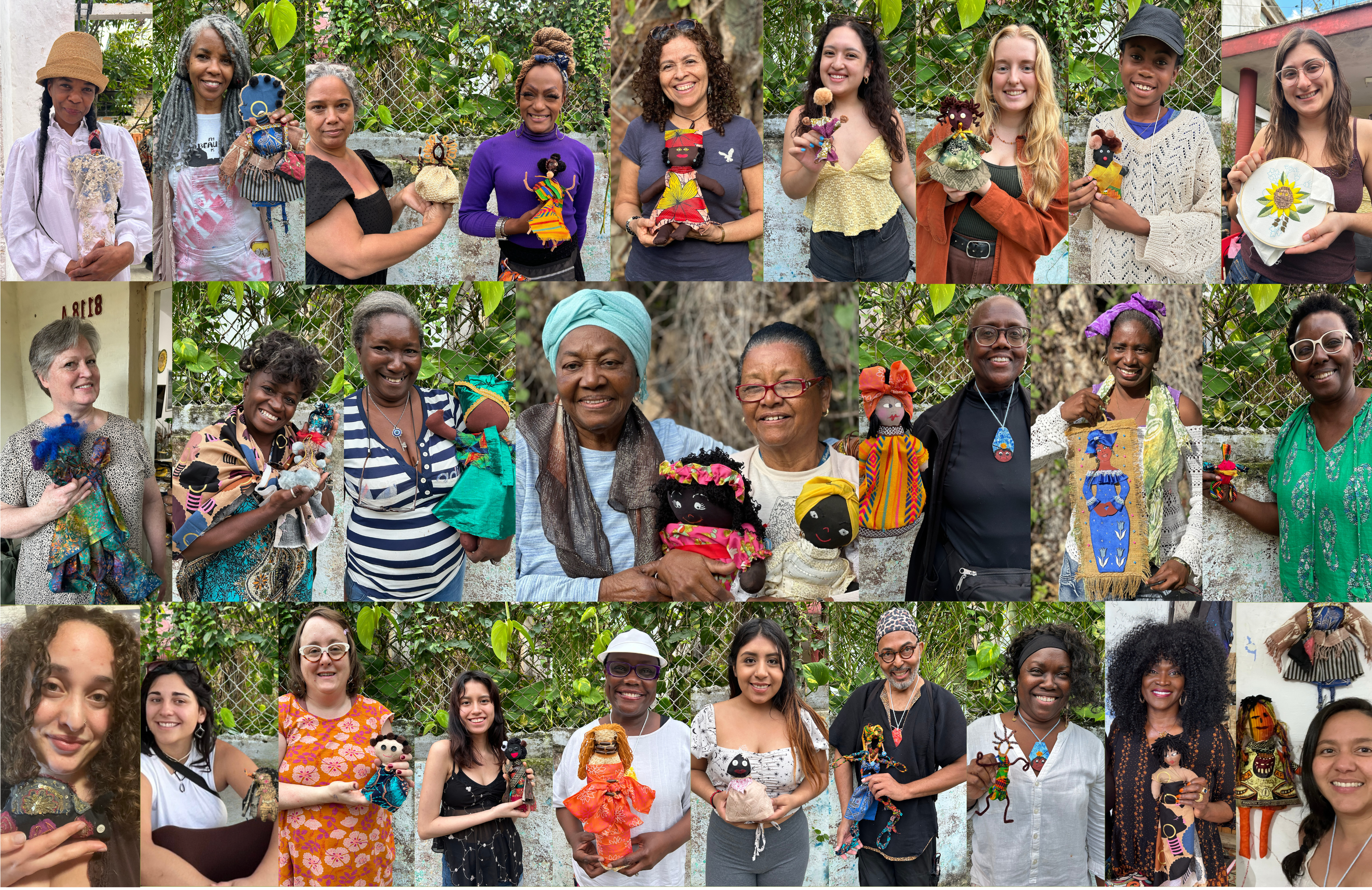
Liliane: My name is Liliane Sojos-Ortiz, and I am a first-generation Ecuadorian-American student at the University of Minnesota, Twin Cities, majoring in Sociology. I am bilingual, fluent in English and Spanish, and have a great passion for using that as a tool for myself and especially others. Community building, activism, and gaining knowledge through experiences are some things that I value and hope to see and use in my future career.
Arianna: I became connected to the Contours project through Cindy García. When I heard her speak about Contours through the Inspire to Change Changemakers Series, which I helped curate while I worked there, I was excited because the project was so multidisciplinary and fluid: it was able to adapt to support different people and processes and put relationship building at the forefront. I was also intrigued by how it was building relationships between artists across different countries. Part of my family is from Mexico, and I studied theater in Havana in 2019 as part of an exchange program where I created an artist book highlighting two contemporary female theater directors in Havana, so I am always excited to connect with people living and working in those countries. I also have experience teaching art and producing theatre and art festivals. So, with my experiences and interests, I felt a sense of alignment and was eager to get more connected to Contours and to learn more about how all of the amazing Black doll artists contributing to this edition were building community via their art and workshops. I believe that art changes everything, and can be a pathway to a more just future, and many of the artists I have met through Contours are creating those paths in their own communities. Although I had never personally met any of the group members aside from Cindy before arriving in Cuba for the residency in March 2024, I was looking forward to spending a week learning, collaborating, and making new connections with people face to face.
Liliane: In my first year at the University of Minnesota, I was granted a scholarship through the “Dean‘s First Year Research and Creative Scholars” program. I was matched with Cindy García through this program, which ended up being one of the best opportunities I have ever been granted. I met with Cindy through Zoom and instantly realized that our values and passions had many things in common. Being Latina and a first-generation student, activism and community building were things that I was always interested in. Cindy offered me a spot on her planning trip to Cuba, where her team of collaborators would be assisting her in planning a bigger residency for the following year. On this trip, I learned about what Contours truly was. I had never felt a greater feeling of inclusivity. During this trip, I translated for the group and offered ideas for the future. During the residency in March 2024, I was able to translate for groups of up to 30, in both English and Spanish, allowing collaborators and community members to share knowledge and experiences, never mind the language barrier. Finally, in November of 2024, I traveled to Mexico with Contours, where we shared the publication with a greater audience and hosted workshops for community members in Tepotzlán. I have enjoyed connecting with people from different backgrounds and especially creating a new community through Contours.
Arianna: The residency in March 2024, where Lili and I first met, took place in Marianao, a municipality in Havana, and over the course of the trip, the group formed intergenerational bonds between elders who have dedicated their lives to their artistry and advocacy, college students carving their own paths, and artists in many stages in between, for some while overcoming language barriers. I find there is a bit of vulnerability that comes with an experience like this. Many of us are meeting people we have never met, for some in a new place, with a new culture, and in a different language. You have to be comfortable with knowing that there is a lot you don’t know. This vulnerable space is also uniquely perfect for making new connections because everyone is in the same boat: experiencing some newness, and all of the excitement, discomfort, and emotions that can come with that.
With all these feelings we began the residency. Throughout the week Black Doll artists, some of whom live in Cuba and others who had traveled from the U.S. and Mexico with their dolls and supplies, shared their skills via a series of workshops. I had never made a doll before, but everyone is a doll artist in these workshops. Each of the professional doll makers had their own unique practices, but the workshops were about more than just the craft of doll making. Many shared the message of how their dolls contributed to a greater sense of self and community empowerment. Their dolls had immense purpose. This became evident when we all had the opportunity to make our own dolls. Professional doll makers and those of us who were just learning were all exchanging skills – teaching each other and sharing stories along the way. It was a space of joy and learning.
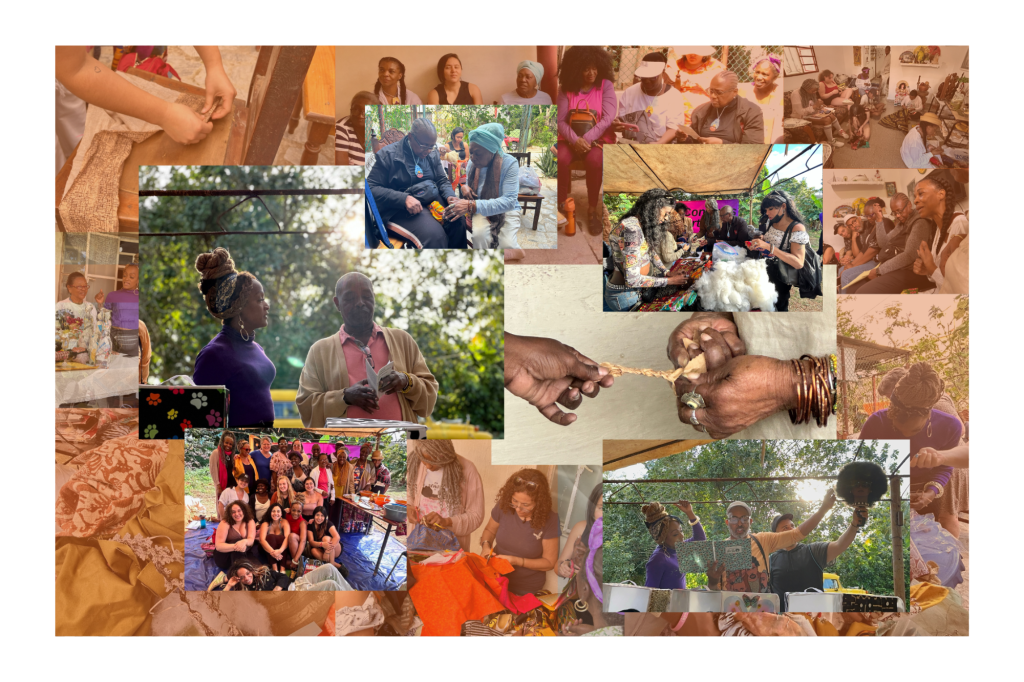
Arianna: I think part of the magic of Contours is that there is power in meeting new people and hearing their stories. When you take the time to get to know someone, you move beyond perceptions, stereotypes, and stigmas. The residency was comprised of artists, activists, and scholars and built relationships primarily between Black and Latina women and gender-expansive people from the Americas, and uplifted Black doll artists, Afro-feminists, and activists working specifically in HIV and AIDS education. We all came with our own unique experiences and skills to share, and with diverse connections between the topics we had gathered around. With people coming from many different places around the world with an openness to share, it was powerful to learn about how everyone is combating racism, sexism, homophobia, and transphobia differently in their countries and communities. This illuminated how every place is unique and how there are so many ways to contribute to a better future for everyone.
Liliane: Being able to translate for this group of primarily women was truly a unique and amazing experience. Translating went beyond just allowing the group to understand each other, but I was able to allow individuals to build relationships, and make connections, some that would have never been made because of a language barrier. Experiences like this have made me realize, even more, how much of a privilege it is to be bilingual. Being in between these connections was a beautiful feeling.
Arianna: Currently, I produce artistic events that connect theatre plays or hands-on craft workshops to civic action and creative advocacy. I have recently been looking at the work I do as creative placemaking, with a goal of creating spaces for community building and collective learning. This often manifests in public art or art making. So much of my experience with Contours directly relates to the events I create in my communities. In my work, I think a lot about the spaces and conditions for having important and authentic conversations about identity. I think about what environmental conditions make people feel comfortable, welcome, and like they belong. During the 2024 Contours residency in Cuba, many of the places where we gathered were homes.
First, we began the residency in Margarita Montalvo’s home for introductions, squeezing into her living room as the rain poured down, meeting each other in person for the first time and learning about Margarita’s project, La Muñeca Negra, from her and her family in the home where it all happens. This is where we had several doll making workshops throughout the week, and got to learn about each of the incredible artists in the group.
Arianna: Later, we traveled to Shalom, a home being built in a more rural area to be a safe haven or retreat space for Queer AfroCubans. Here, we also connected with people doing work around HIV and AIDS in different parts of the island, and we had time to chat with some folks individually to hear how each of them approach their work differently. This is where Dr. Cynthia Davis of Drew University in Los Angeles gave a workshop about destigmatizing HIV/AIDS through her Dolls of Hope Project.
Arianna: Our week in Cuba ended with our day of ArteCalle at the Casa Tomada mirArte. This home generously welcomed the Contours collective with dance, food, and love. Our dolls that had been crafted during the week of workshops lined one of the walls in the space for the public to see, and an altar was formed in front of them to honor the ancestors. The festival spilled out onto the street for a series of performances, including an improvised dance performed by the entire Contours group and inspired by all doll making. We ended the night with drag performances and live music from Grupo Vocal Baobab for everyone to dance into the night.
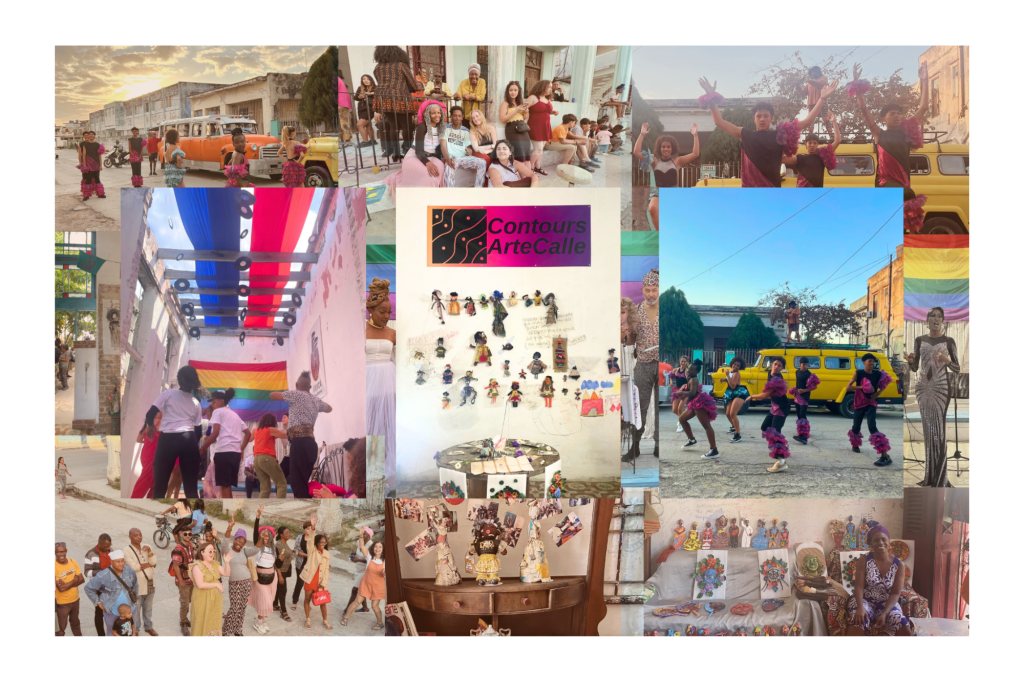
Arianna: Casa Tomada mirArte is another home and one that has my favorite combination of qualities: being multifunctional, created with purpose or being mission-driven, and prioritizing creativity and community. This all adds up to make for a really powerful creative gathering space and often creates a feeling of a space being sacred. Sacred in the sense that a lot of positive energy has filled the space over time, and you feel that upon entering. Homes are such intimate and often private spaces, so the invitation to learn and connect, sometimes over food or hands-on workshops, created beautiful and comfortable settings for people to open up to one another. Spaces like these, and opportunities to exchange with people from different cultures, are crucial to the fight against racism, sexism, homophobia, and transphobia. For me, Contours has been an opportunity to reexamine my own power and gain new tools for my own work against these forces in my own communities.
The reverberations of all of these ephemeral events that took place during this residency continue to make an impact in my life and work, and it has been beautiful to witness some of our relationships blossom into new connections and experiences in the year since we were in Cuba. For example, several Contours group members visited one of Cindy’s classes at the University of Minnesota to share about our experiences, and I was able to help Cindy and Cynthia Davis organize a doll making workshop for community members at Pillsbury House and Theatre, in Minneapolis, where I worked. Contours has built a new transnational community and support system.
Contours in a New Context: Mexico, 2024
Arianna: Thanks to Tanya Duarte and her project Afrodescendencia Mexico, members of the Contours group were invited to Mexico in November of 2024 to share about the publication, our experiences with the residency in Cuba, and make new connections through workshops and engagements with people in Mexico City and Tepoztlán, Morelos. This trip proved to be really helpful for better understanding what Contours is, my own role in it, and how this framework for collaborating can be useful in new places. This opportunity also helped us reground and communicate our goals for the future as a group.
A foundation of Contours is relationship building. By placing that at the center, we are then able to learn so much from one another’s different lived experiences and expertise, and hear from each other firsthand how we can each use our skills to support each other’s lives and practices. Because of this, we often share skills in intimate ways, over a meal or a hands-on workshop. When our group was invited to share about our experiences on a stage from behind a podium at the Benjamin Franklin Library at the US Embassy in Mexico City, while I was honored, I also felt a little out of place. During this experience, we also got to hear from two Mexican scholars, Sagrario Cruz-Carretero and Elia Avendaño Villafuerte about their work regarding structural racism in Mexico and the inequities that many Afrodescendent and Indigenous Mexicans face. Additionally, we were able to share our stories with a wider audience as the presentations were also live-streamed through the Library. Helping to share and preserve our stories of connection, learning, and activism is so important, and I want to thank Tanya and the Library for helping us to do that.
After our formal presentations, many of us were eager to connect with local people and learn more about how our work might resonate with people in this new context. We traveled to Tepoztlán, Morelos, where Tanya grew up. She generously introduced us to her mother, closest friends, and we got to walk through the streets of town on our own to get to know the area. On one of our first days in Tepoztlán, a group of us stumbled into the public library, Biblioteca Pública Amoxtlahtolpialoyan Lic: Anicet Villamar. A group of women were working on felt Christmas decorations, and we began to speak with a library staff member about our work and Cynthia Davis’ Black Doll making workshop, which she had brought supplies to Mexico to lead at a restaurant that Tanya had lined up. The librarians were excited to meet us all, and we offered to bring the workshop to the library as well while we were in town, to which they were happy to host us. A few days later we arrived with supplies in hand and a multigenerational group of people sat down to learn how to make a doll. Most participants had never made a doll before, and they were so excited to connect with us all and spend an hour or two making.
While Cynthia was leading the workshop, Lili helped to translate and I took photos and videos of the workshop in action. The workshop went so well that some participants asked if we could return again the next morning as they knew more people who would love to attend, so we came back the next morning to an even fuller room.
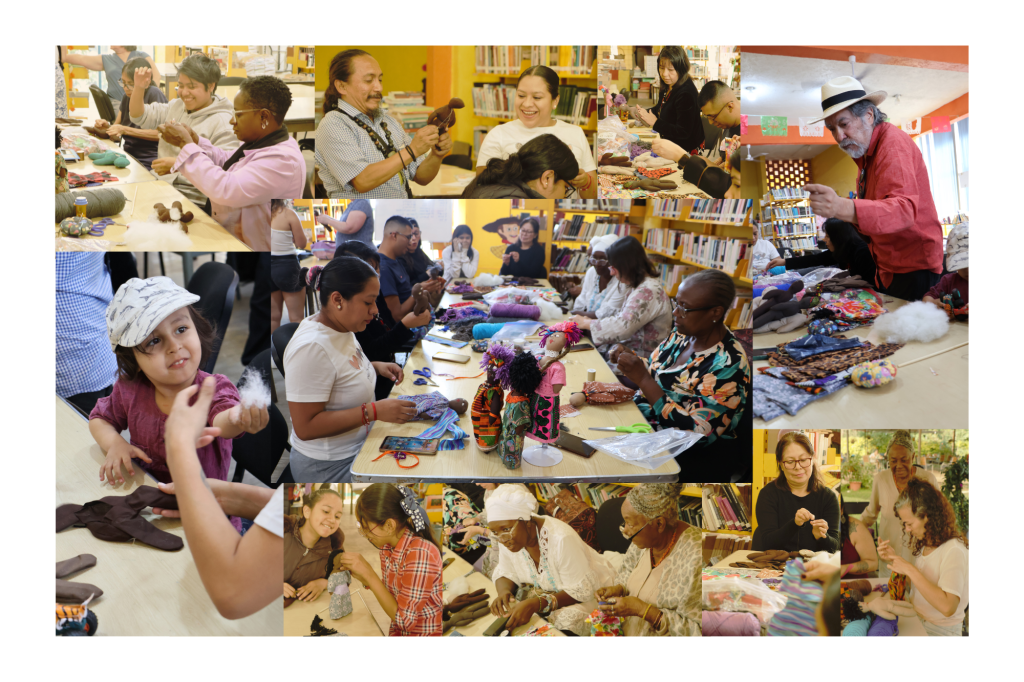
Liliane: Translating this workshop was one of the highlights of my week in Mexico. I entered the space a couple of minutes after the workshop began, so Cynthia was already demonstrating her doll workshop with actions like pointing and using keywords. When I began to translate Cynthia’s explanations word for word, the faces of those who were participating lit up. They were following her gestured directions correctly, but the relief of a familiar language lightened up everyone’s faces. Through this workshop, many of the Contours collaborators were also able to make connections with the community members. Being able to translate the community member’s gratitude towards Cynthia was also beautiful. Seeing Cynthia’s face light up with joy, knowing that she once again, made a difference was a memorable moment. At the end of the workshop, we were able to interview some of the workshop participants. I translated the interview questions, and hearing their answers was truly heartwarming. One highlight was an older man confessing that he only stayed because, “there was another man participating,” but he resulted in making his mother a doll and connecting with his inner child. “I would share with my community that making a doll does not question my masculinity, but rather offered me an opportunity to connect with my inner child”.
Arianna: As the photographer, it was beautiful to watch each of these brilliant women connect and share their skills with folks at the library. Cynthia led participants through the process of making the dolls, but Maritza Arango Montalvo and Margarita Montalvo who are also expert doll makers with their project La Muñeca Negra in Cuba, used their skills to help guide people as well and utilize the materials in new ways. Myrna Padrón Dixon, founder of La Casa Tomada mirArte, connected with a young nonbinary participant who was so excited to get to make a doll of their own. Cindy García, Lili, and I worked with a group of middle school girls as they sewed and customized their dolls’ hair. A few of the girls practiced their English as their English teacher had brought them to the workshop instead of teaching her English class as usual. The video interviews of workshop participants that Lili mentioned were also so impactful, and shed light on how much power even a few hours of collective art-making can have. It was an honor to get to document and preserve a small bit of our experience from behind the camera.
Seeing how our group thrived in this spontaneous public workshop at the library helped me to think about Contours in a new way. A few things stood out to me as guideposts or values. We seem to best work by being: participatory, collaborative, mutually beneficial, public, and flexible. Engaging with people through participatory craft-based workshops creates an intimate environment for people to open up and connect. These workshops are collaborative and invite people to share their skills by being both a teacher and a learner. We aim for the experiences to be mutually beneficial so that the people we are engaging with are benefitting from connecting with us, just as we are benefiting from connecting with them. It is important to us that we take the time and care to listen to community members in the places we are visitors, so that our presence may contribute rather than hinder or harm. By engaging with people in free public spaces our experiences are more accessible to a wider range of people regardless of their income or identities. Lastly, our collective skills and our schedule are flexible enough to allow us to accommodate the spaces we are in and cater to the people we are with, placing people first in the work we do.
Being a part of Contours for a second time, in a new place, has made me think more deeply about how these values also show up in my life, and in the theatre events and workshops I produce in my communities in Boston.
Liliane: As a University student, they reiterated the values that I hope to see and bring to my future career and workplaces, but also those that I try to bring everywhere, in my day-to-day life.
While the writing in this edition captures some of our experiences, it cannot contain it all. The title “Contours” speaks to this. It is an outline of something ever-changing, mirroring the nature of relationship-building and collective artistic creation. As the two youngest members of Contours in Mexico, we were affectionately called “las semillas”, which translates to “the seeds”. We translated and photographed the trip in Mexico, and learned so much from these experiences and the people we had the honor of collaborating with. We are grateful to everyone who was a part of the residency in both Cuba and Mexico, to those who welcomed us into their homes, and those who spent hours organizing these trips and creating the conditions for all of us to make new connections.
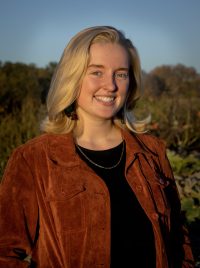
Arianna Diaz-Celon (https://www.ariannadiazcelon.com) is a multidisciplinary artist, organizer, and storyteller who uses the arts as a catalyst for community building and collective learning. They create spaces, events, and art that help to bring people together and facilitate an exchange of energies, ideas, and stories. In addition to their own artistic practice, they are passionate about supporting other storytellers and change makers. They strive to utilize the skills they have to support Black, brown, and queer artists and communities, whose stories have been historically silenced and omitted, tell their own narratives. They have worked extensively with Exposed Brick Theatre, based in their home state of Minnesota, whose mission is to tell untold stories, center omitted narratives, and create art at the intersection of identities. They currently serve as the Connectivity Producer at Company One Theatre in Boston, whose mission is to build community at the intersection of art and social change. At C1, they are the artistic producer of the Better Future Series, which brings together and activates Boston’s artists, community leaders, policymakers and residents through free hands-on workshops in order to understand the needs of our neighborhoods and reimagine a better future for our city.
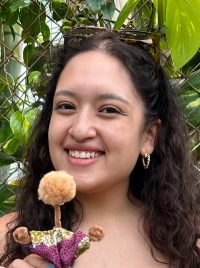
Liliane Sojos-Ortiz is an Ecuadorian-American, first generation, undergraduate student at the University of Minnesota. She is majoring in Sociology. She is the Undergraduate Research Assistant of Cindy García, and has traveled to Cuba and Mexico with Contours. In 2023, she assisted with translating and planning for the 2024 residency in Havana, Cuba, while also building strong relationships with Cuban collaborators. Throughout the 2024 residency, she translated for a large group, in both Spanish and English, allowing collaborators from the U.S., Cuba, Mexico, Brazil, to build relationships and share experiences with each other.
